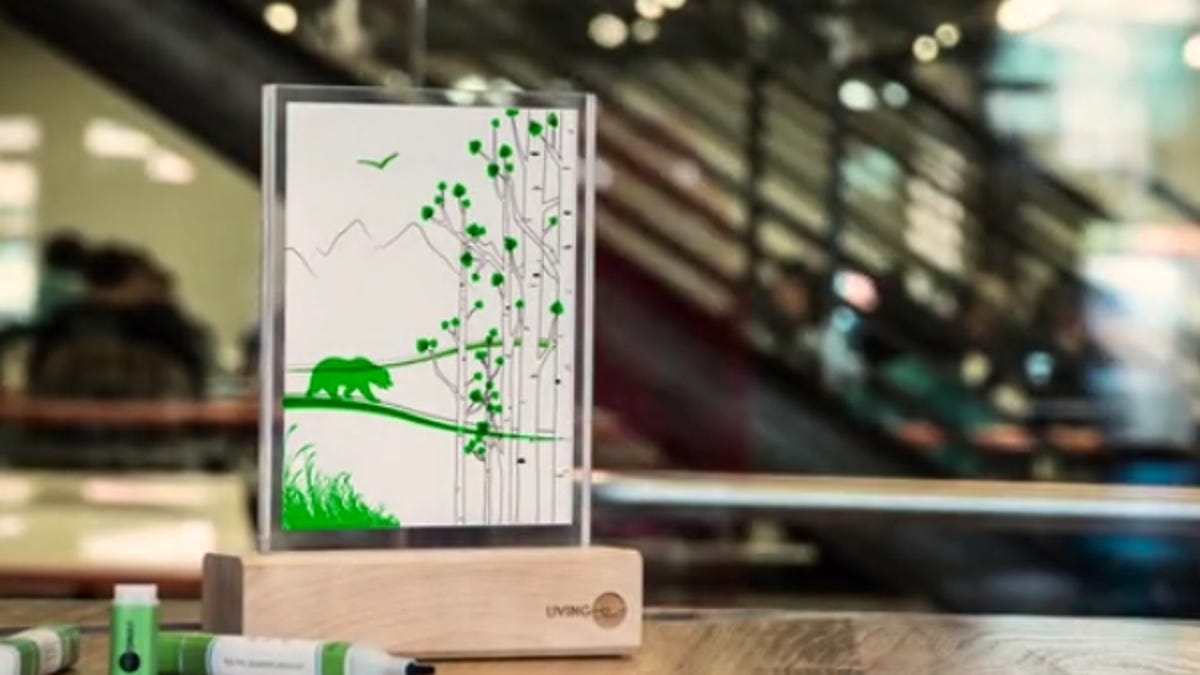Time-lapse bio ink blooms to reveal your secret writing
Remember those invisible ink pens? A new kind of ink made from algae lets you write or draw now, so someone can see your creation in stages.
Any kid with even a passing interest in the world of international espionage used to know that you can create secret messages with lemon juice and a heat source. Now, a company called Living Ink Technologies says it's created an invisible ink that reveals itself naturally over the course of a few days -- no heat needed.
According to the product's Kickstarter page, the water-based ink is mostly made from algae and cyanobacteria, tiny harmless organisms that use photosynthesis to create their own food.
When you apply the ink to paper, it momentarily appears pink or blue before turning invisible. You then put the paper in a special frame called "the greenhouse" and over the course of a few days, as the bacteria grow, whatever you've written or drawn becomes visible.
"When they hit the paper they are at about 1 million/cells per mL (not too concentrated) so you can't see the cells with your eye," Living Ink co-founder Scott Fulbright told CNET's Crave blog. "As they grow and multiply they turn into billions of cells per mL (very concentrated) and they are visible to the eye." Fulbright says the bacteria can only grow where the pens touched the page and eventually they stop growing because the cells get too dense and crowd out the sunlight they need to expand.
Once the ink has shown up and you remove the picture from the frame, the ink is expected to remain stable; Fulbright says his team has samples that have lasted over two years.
There are two types of ink -- one that appears in about two days and one that takes about three days. You can combine these inks with regular pen or pencil to dramatic effect. For example, you could draw two stick figures using regular ink. A few days later, the words "you" and "me" could appear over each. Then, a day or two after that, the sentence could be completed: "Will you marry me?" (No charge for that nugget of matrimonial inspiration for all you people out there looking for a creative way to pop the question, by the way.)
In addition to being fun, Living Ink is also nontoxic. "Most colored pigments found in regular ink are made up of heavy metals like cadmium, copper, chromium, iron, lead and aluminum," says the company on its Kickstarter page. "Carbon black is the most common pigment used in black inks. It's most commonly made from ... the incomplete combustion of heavy petroleum products such as tar." Living Ink Technologies sidesteps these chemicals by making its product out of the ultimate organic material -- living organisms.
That, though, presents one of the drawbacks to Living Ink. Because it depends on life, unused ink in the pens only lasts about three weeks. Also, the pens only hold enough ink for about three uses. After that, the ink needs to be refilled. Fulbright told Crave that his company plans to sell pen and paper refills for $1 each (about 66p, AU$1.39), though, so the expense if you want to keep using Living Ink is fairly reasonable.
To get started writing and drawing with algae and bacteria, you can pledge $25 (about £17, AU$35) via Kickstarter for the promise of a pen filled with the faster-appearing ink, the frame and three pieces of paper. Bump your pledge up to $40 (about £27, AU$56) and you should get five pieces of paper, the frame and both speeds of ink. Although Living Ink Technologies says its product might work on different papers, due to acids in paper, it recommends using the paper it supplies.
The company has nearly doubled its fundraising goal of $15,000 (about £9,962, AU$20,870) and has almost a month left in its campaign. Living Ink kits are expected to ship in March 2016. Bear in mind that not all Kickstarters pay off on time or as expected.


